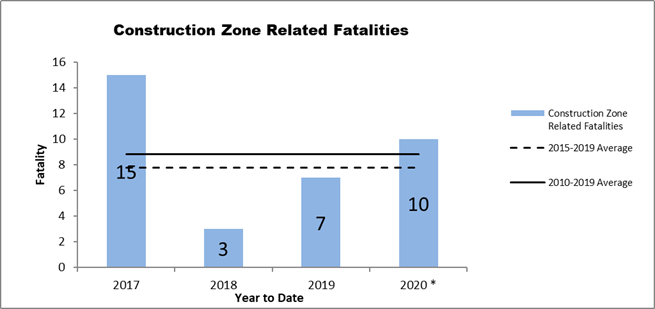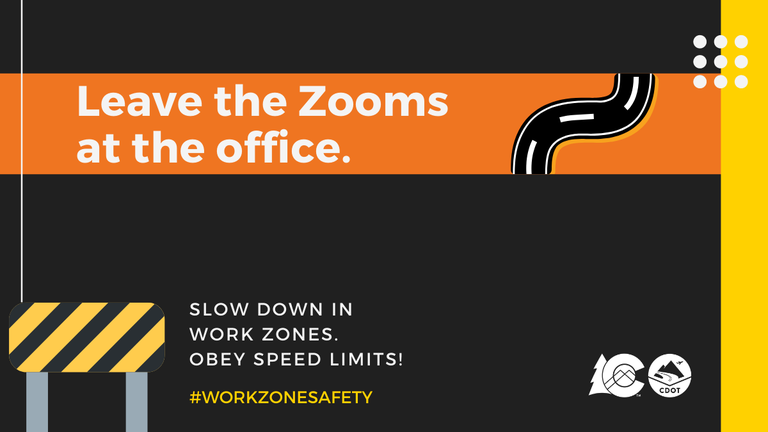CDOT and CSP warn that not all workplaces are meant to zoom
The State of Colorado has seen an uptick in fatal crashes in construction work zones in 2020, according to data gathered by the Colorado Department of Transportation. Statewide there have been 10 traffic fatalities in construction zones, up from seven this time last year. Five of the 2020 fatalities have occurred in the Denver metro area, far higher than the two fatalities that had occurred at this time last year.
“The rate at which we are seeing fatalities within work zones is alarming,” said CDOT’s Executive Director Shoshana Lew. “Many of these crashes have been caused by excessive speed. Each construction and maintenance project has a comprehensive traffic control plan to ensure everyone’s safety but we need motorists to slow down and be attentive when they enter a construction zone.”

Statewide construction zone related fatalities data from Jan. 1 to Nov. 18

Denver metro construction zone related fatalities vs. statewide
construction zone fatalities data
"Workers spend all day in a potentially dangerous situation to make sure that our infrastructure is safe for Colorado drivers," said Lew. "Our crews wear personal protective equipment so they can easily be seen, traffic cones help guide vehicles and attenuator trucks are staged in the area to mitigate crash impacts in a work zone. Drivers need to do their part to follow traffic safety rules and avoid speeding. Speed limits are reduced in work zones for a reason.”
Despite lower traffic volumes due to COVID-19, speed continues to be an issue in work zones. The Colorado State Patrol and local law enforcement agencies have recorded speeds over 120 miles per hour. In 2019, CSP issued 2,975 speeding citations in the following four construction zones: I-25 South Gap, Central 70, I-70 Peak Period Shoulder Lane Mountain Corridor project and the I-25 North Express Lanes: Johnstown to Fort Collins project. In addition, an additional 4,898 citations for unsafe driving behavior were issued. Within a 19-day period in October 2020, the Denver Police Department made 96 traffic stops for vehicles traveling an average of 82 MPH within the Central 70 Project area and reported over a dozen vehicles traveling 100 MPH or higher.
“It is critical that motorists recognize and follow the posted speed limits while driving through work zones,” said Colorado State Patrol Chief Matthew Packard. “Drivers should anticipate changing conditions such as narrow lanes, concrete barriers, slow-moving heavy equipment, or uneven pavement - all of which reduce room for errors. Your Colorado State Troopers are serious about enforcing safe driving to save lives in construction zones and motorists should take this seriously too.”
Fines are doubled in all work zones and enforcement is on-going. Therefore, it is critical that every driver go slow in construction zones and use caution. The life saved may be your own.
Safety is CDOT’s top priority and urges the public to make it theirs, too.
REMEMBER: SLOW FOR THE CONE ZONE
The following tips are to help you stay safe while traveling through maintenance and construction work zones.
● Do not speed in work zones. Obey the posted speed limits.
● Stay Alert! Expect the unexpected.
● Watch for workers. Drive with caution.
● Don't change lanes unnecessarily.
● Avoid using mobile devices such as phones while driving in work zones.
● Turn on headlights so that workers and other drivers can see you.
● Be especially alert at night while driving in work zones.
● Expect delays, especially during peak travel times.
● Allow ample space between you and the car in front of you.
● Anticipate lane shifts and merge when directed to do so.
● Be patient!

COVID-19
Safe transportation infrastructure is essential for emergency first responders and freight drivers as Colorado navigates the COVID-19 pandemic. With that in mind, road maintenance and construction continue on CDOT projects with social distancing and other health safety measures to reduce COVID-19 exposure on the worksite. The Colorado Department of Public Health and Environment announced guidelines for construction activities. The public is urged to join the campaign for #DoingMyPartCO by practicing social distancing, wearing face masks, staying at home when possible, and avoiding nonessential travel. With fewer vehicles on the roads, CDOT crews will be able to work more efficiently and safely.
WHOLE SYSTEM. WHOLE SAFETY.
To heighten safety awareness, CDOT recently announced its Whole System — Whole Safety initiative. This project takes a systematic statewide approach to safety combining the benefits of CDOT’s programs that address driving behaviors, our built environment and the organization's operations. The goal is to improve the safety of Colorado’s transportation network by reducing the rate and severity of crashes and improving the safety of all transportation modes. The program has one simple mission—to get everyone home safely.
ABOUT CDOT
CDOT has approximately 3,000 employees located throughout Colorado, and manages more than 23,000 lane miles of highway and 3,429 bridges. CDOT also manages grant partnerships with a range of other agencies, including metropolitan planning organizations, local governments and airports. It also administers Bustang, the state-owned and operated inter-regional express service. Governor Jared Polis has charged CDOT to further build on the state’s multimodal mobility options.
